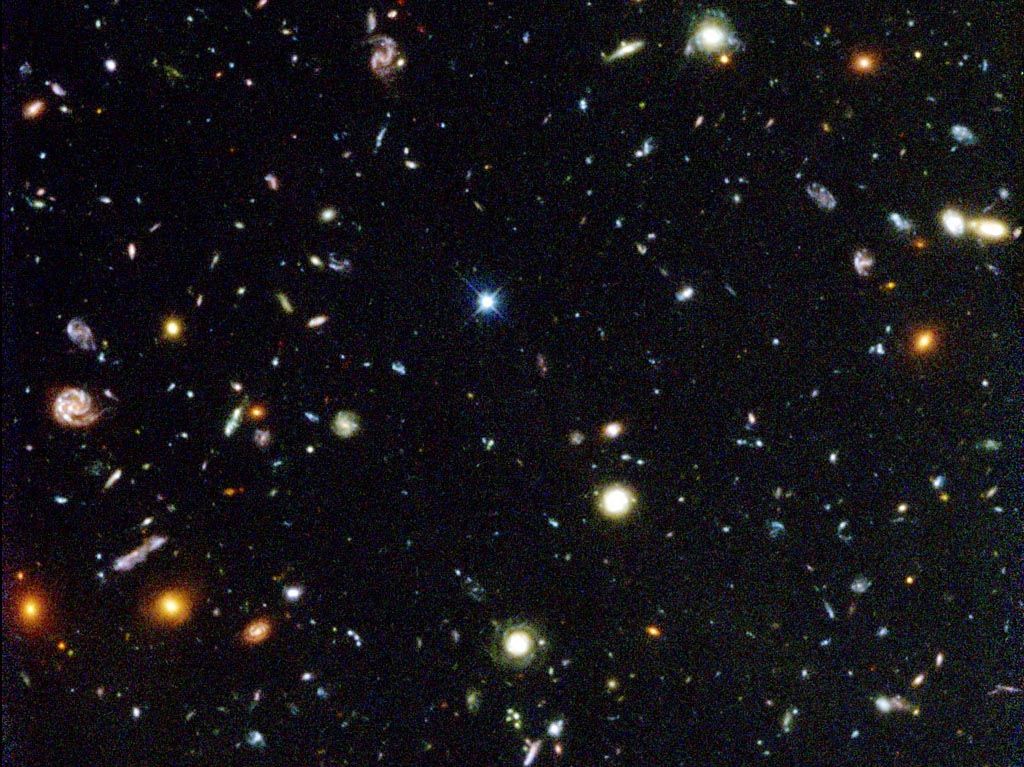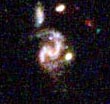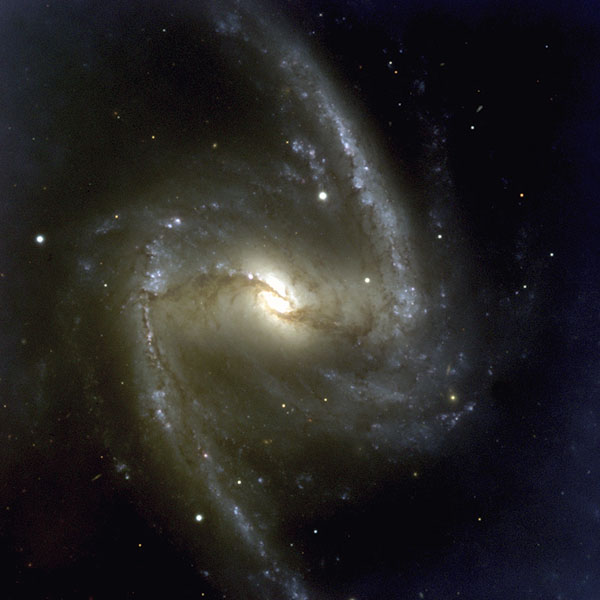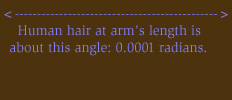Vast vision must improve our sight. The Moody Blues
In 1996, the Hubble Space Telescope was used to make a series of exposures of an area of the sky in the Northern Hemisphere, which was selected as a "window" to see the most distant galaxies, quasars etc. with few stars from our own galaxy getting in the way. Here are some images - and a second page with new theories regarding the cosmological redshift and the "Big Bang" theory.
10 March 2004: there's a new, much more ambitious image - the Hubble Ultra Deep Field:
http://hubblesite.org/newscenter/newsdesk/archive/releases/2004/07/
They believe they are seeing about 10,000 galaxies, only 400 to 800 million years after the "Big Bang". There's a fab 62 Megabyte JPG image . . . 6200 x 6200 pixels . . . Dig it!To the parent directory - astrophysics - from where you can reach other parts of this First Principles site - for many other things, such as the world's longest Sliiiiiiiiiiinky.
My
new site http://astroneu.com has a
lengthy treatise for specialists on new theories regarding redshift of
light by low-density plasmas (including coronal plasmas
and the ISM / IGM) and how this may explain many things about quasars,
the heating and acceleration of the solar corona, as well as the
cosmological redshift.
For more philosophical approaches to cosmology, see:
- God and Mother Nature on the imminent release of Nature 2.0 ../../eclectic/nature-2.html .
- Me on why it is scientifically (but perhaps not mystically)
impossible to understand for sure why
there is anything at all, any forces, any dimensions etc.
(matter and energy are minor considerations by comparison!) ../../robin/
Check the Wayback Machine to see earlier versions of this page: http://www.archive.org .
The somewhat false-colour image below was created from multiple exposures through blue, red and infra-red filters. The CCD-based (Charged Coupled Device - silicon image sensor) camera has four sensors and one of them sees a smaller section, in greater detail, because its mirror gives it twice the magnification. A small version of the image is here:
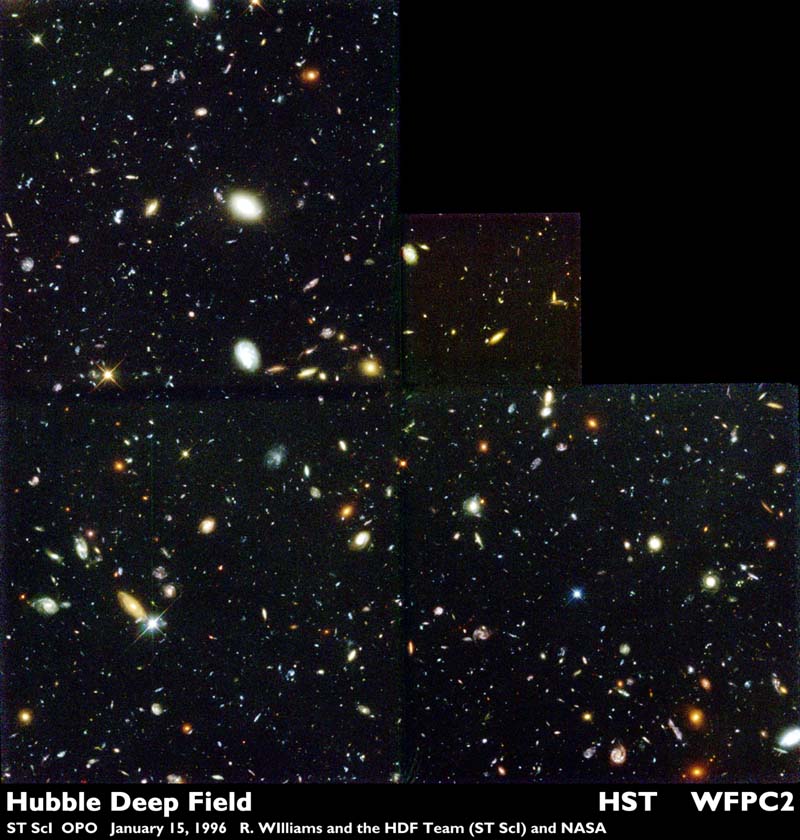
The page with these images is: http://hubblesite.org/newscenter/archive/1996/01/ and Googling Hubble Deep Field turns up 32,000 pages. The above image covers an area of the sky 3 x 3 arc minutes. The Moon's or the Sun's apparent diameter from Earth is about 30 arc minutes - half a degree.
The project page with the technical details is: http://www.stsci.edu/ftp/science/hdf/hdf.html . The field is located (J2000 coordinates) at right ascension (AKA longitude) 12h 36m 49.4000s and declination (AKA latitude) +62d 12' 58.000" This is in Ursa Major (the Big Dipper):
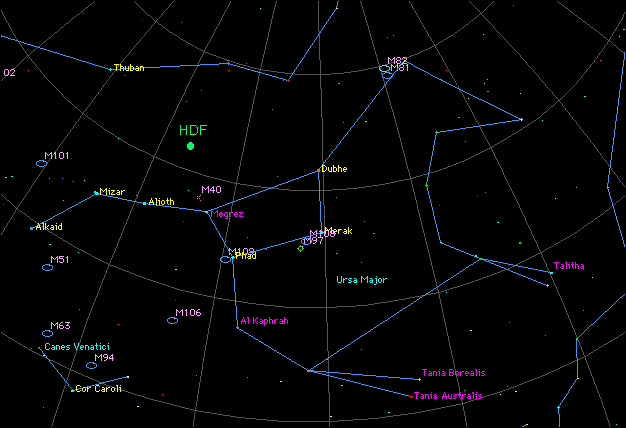
(Image adapted from http://homepage.mac.com/kvmagruder/bcp/aster/constellations/UMa.htm , made with Voyager II software from http://www.carinasoft.com .)
Here is a page where you can click on another version of the above image to find information about each of the 1015 galaxies and 6 stars - their redshift (photometric estimate based on colours and in some cases based on a true spectrogram): http://nedwww.ipac.caltech.edu/level5/Deep_Fields/mirror/hdfn/
Likewise for a similar field in the south: http://nedwww.ipac.caltech.edu/level5/Deep_Fields/mirror/hdfs/ for which the project page is http://www.stsci.edu/ftp/science/hdfsouth/hdfs.html .
Here is the full resolution .jpg - 3069 pixels square - 2 Megabytes: 1996-01-c-full_jpg.jpg .
From the bottom left section, a 1024 pixel wide section is available as a .jpg (572 kbytes) Hubble-Deep-Field-1024-wide.jpg and as a .BMP (3.2 Megabytes) suitable for using as a Windows desktop wallpaper: Hubble-Deep-Field-1024-wide.bmp (To use this, shift click on the link and save it somewhere on your hard drive. Then use Start > Settings > Control Panel > Display > Background > Browse to select it.)
Here is my own selection, from the bottom right section, including what I assume is one local star. I have rotated it clockwise 90 degrees.
This image is 1024 pixels wide x 767 pixels high.
It covers an area of the sky 1.5 arc-minutes wide and 1.125 arc-minutes high.
(1 arc minute = 1/60th of a degree. 1 radian = 57.3 degrees. )
1.5 arc-minutes wide x 1.125 arc-minutes
= 0.00044 x 0.00033 radians.
=1.43 x 10-7 square radians (steradians, of which there are 4pi in a complete sphere).
= 1/88,000,000 of the sky.
Looking at one such area per second, it would take 2.79 years to see the whole sky.
(Below, I call this the BIG image.)
The "galaxy 204" should appear directly below here.
